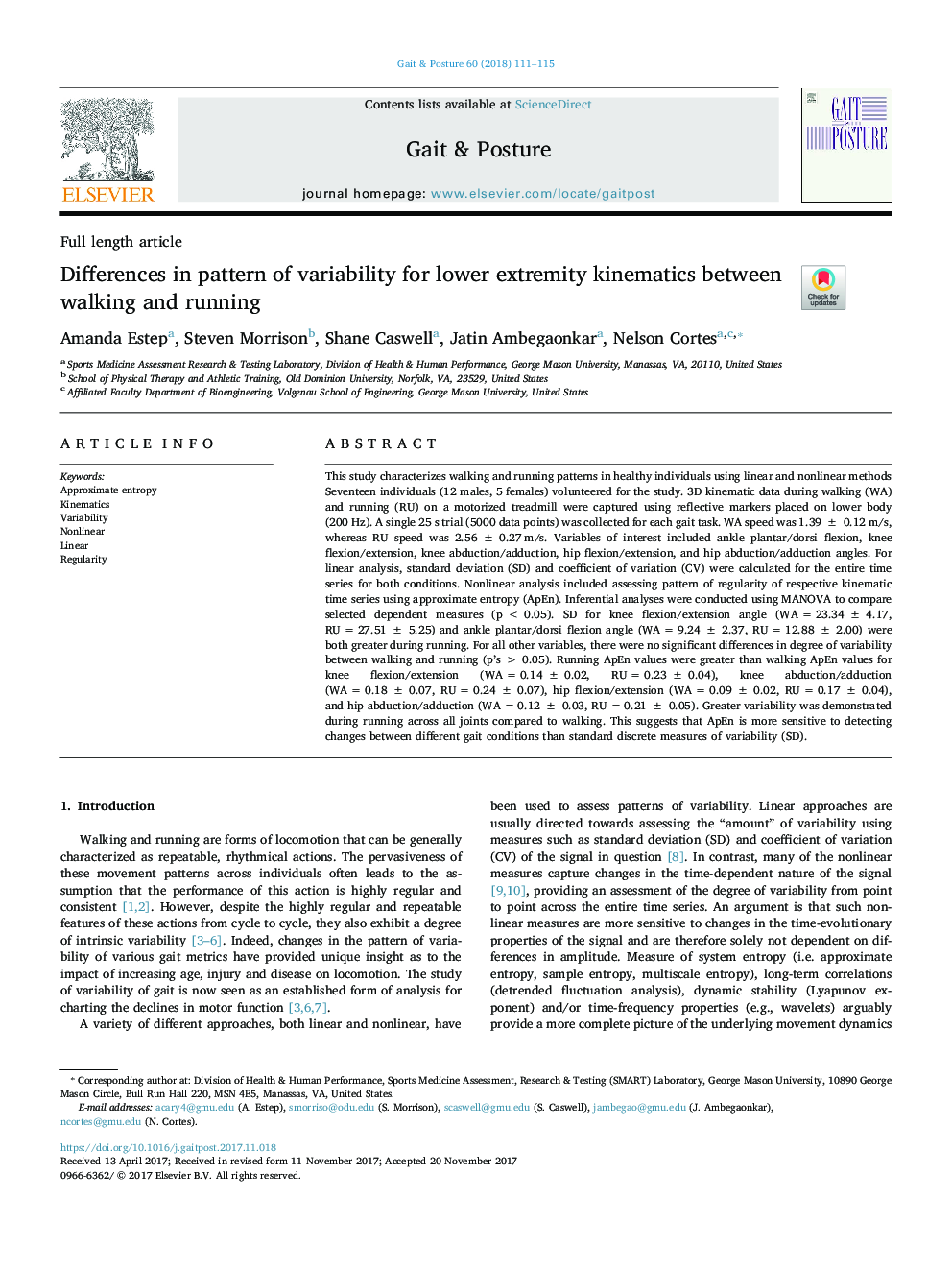| کد مقاله | کد نشریه | سال انتشار | مقاله انگلیسی | نسخه تمام متن |
|---|---|---|---|---|
| 8798638 | 1603835 | 2018 | 5 صفحه PDF | دانلود رایگان |
عنوان انگلیسی مقاله ISI
Differences in pattern of variability for lower extremity kinematics between walking and running
ترجمه فارسی عنوان
تفاوت الگوی تغییرپذیری برای سینماتیک اندام تحتانی بین راه رفتن و راه رفتن
دانلود مقاله + سفارش ترجمه
دانلود مقاله ISI انگلیسی
رایگان برای ایرانیان
کلمات کلیدی
موضوعات مرتبط
علوم پزشکی و سلامت
پزشکی و دندانپزشکی
ارتوپدی، پزشکی ورزشی و توانبخشی
چکیده انگلیسی
This study characterizes walking and running patterns in healthy individuals using linear and nonlinear methods Seventeen individuals (12 males, 5 females) volunteered for the study. 3D kinematic data during walking (WA) and running (RU) on a motorized treadmill were captured using reflective markers placed on lower body (200 Hz). A single 25 s trial (5000 data points) was collected for each gait task. WA speed was 1.39 ± 0.12 m/s, whereas RU speed was 2.56 ± 0.27 m/s. Variables of interest included ankle plantar/dorsi flexion, knee flexion/extension, knee abduction/adduction, hip flexion/extension, and hip abduction/adduction angles. For linear analysis, standard deviation (SD) and coefficient of variation (CV) were calculated for the entire time series for both conditions. Nonlinear analysis included assessing pattern of regularity of respective kinematic time series using approximate entropy (ApEn). Inferential analyses were conducted using MANOVA to compare selected dependent measures (p < 0.05). SD for knee flexion/extension angle (WA = 23.34 ± 4.17, RU = 27.51 ± 5.25) and ankle plantar/dorsi flexion angle (WA = 9.24 ± 2.37, RU = 12.88 ± 2.00) were both greater during running. For all other variables, there were no significant differences in degree of variability between walking and running (p's > 0.05). Running ApEn values were greater than walking ApEn values for knee flexion/extension (WA = 0.14 ± 0.02, RU = 0.23 ± 0.04), knee abduction/adduction (WA = 0.18 ± 0.07, RU = 0.24 ± 0.07), hip flexion/extension (WA = 0.09 ± 0.02, RU = 0.17 ± 0.04), and hip abduction/adduction (WA = 0.12 ± 0.03, RU = 0.21 ± 0.05). Greater variability was demonstrated during running across all joints compared to walking. This suggests that ApEn is more sensitive to detecting changes between different gait conditions than standard discrete measures of variability (SD).
ناشر
Database: Elsevier - ScienceDirect (ساینس دایرکت)
Journal: Gait & Posture - Volume 60, February 2018, Pages 111-115
Journal: Gait & Posture - Volume 60, February 2018, Pages 111-115
نویسندگان
Amanda Estep, Steven Morrison, Shane Caswell, Jatin Ambegaonkar, Nelson Cortes,
